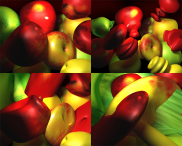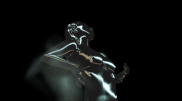I exhibited in the contemporary art context for fifteen years before I turned to 3D animation. Between 1998 - 2000, I took classes at New York University's Center for Advanced Digital Applications to learn Maya 3D animation software.
In 2000, I began teaching Maya classes. At that time I was not familiar with media-production oriented vocational training, the context where 3D animation teaching first developed. To my surprise, I found that standardized 3D curriculum, oriented towards students intended for commercial production, was deadening to their ability to think actively and inductively.
The 3D problem is the result of pedagogical structures borrowed from a specific style of industry pipeline created to produce corporate effects films. These are films that are assembly-line in their manufacturing style. Skills are taught with an eye towards narrow specialization. As a result, students are literally taught to resist big picture thinking, which means to resist thinking conceptually, holistically and along with that, creatively.
When I arrived at the School of the Art Institute of Chicago in the fall of 2007, I was encouraged by Tiffany Holmes, then chair of my former department - Art and Technology Studies - to write curriculum for a new kind of 3D animation studio class. Each one utilized virtual imaging and 3D animation, techniques capable of simulating sculpture, painting, architecture, photography and film or video, depending on the approach taken. My concept was that 3D animation and imaging software could be deployed along divergent paths, each building upon different art histories and therefore different contextual and theoretical trajectories.
My classes bundle conceptually and formally related skills. Digital Bodies uses experimental dance films as the artistic inspiration for teaching character animation. Virtual Installation is a course in which computer models could be "installed" in non-sites, meaning imaginatively integrated into photographs and video. Atmospheric Animation is a class in which fluid environments evoke atmospheres, to create a stage for enacting physics simulations. Painting in the Virtual Environment is a course that emphasizes the possibilities of the pictorial and of surface structure in 3D forms. Introduction to Experimental 3D is the core class, modeled after Johannes Itten’s Bauhaus Basic Course.
The potential of 3D animation within contemporary art practice is not yet fully realized. I believe this is because of the industry-oriented style of training. Typically, students are offered classes with titles like: Modeling, Rigging, Character Animation, Rendering, Texturing, etc. These are classes named for specific technologies rather than their creative potentials. Educational one-line tutorials and the exploding DVD tutorial business offer a plethora of exercises as homework assignments: "Make a cartoon walk cycle," model a grisly humanoid monster, or create a highly lacquered sports car. This is an infrastructure that reflects an assembly-line consciousness that is microcosmic and lends itself to cog-like thinking.These educational tools also result in the production of an unacknowledged "company style." They teach not just skills but the aesthetics conveying the values and ethos of a certain corner of the media industry: the culture of shooter games, splatter films and Disney cartoons.
The Experimental 3D curricular track at SAIC is the first of its kind. It has opened the medium up to a different kind of student. These are not just students with aspirations to practice contemporary art, of which there are many, but also those who want to be independent film directors and high-end art directors. The proof of the pudding, however, is in the eating. When I first arrived in Chicago, my class registration was low. After three years, my classes are fully booked shortly after they open for registration.

Intro to Experimental 3D
This class recreates Johannes Itten's basic course developed at the Weimar Bauhaus School, but here using Maya 3D software. Students solve a series of formal problems, at increasing levels of complexity. Moving from 2-dimensions to 3-dimensions to 4-dimensions (time), students evolve their abilities to utilize aspects of light and dark, form, rhythm, color, proportion and volume at the same time as being introduced to this complex software interface.

Painting in the Virtual Environment
Using Maya 3D animation software, students create virtual still life paintings. Each contributes organic, industrial and digital objects and works in a team to compose allegorical still lives first recorded as a photograph to serve as the basis of a 3D computer model. Digital sculpting, painting, and photo-realistic lighting simulation are taught. Significant class time is spent on historical precedents from Cezanne to contemporary set-up photographers like Thomas Demand and Sam Taylor Wood.

Atmospheric Animation
This class teaches particle effects using Maya. Students create an underwater environment as a case study, both to learn Maya dynamics in particular, and generally, how to approach making an elaborate special effects scene. The class evolved from my piece, Ophelia. In creating it, I developed techniques and composed a 50- page "recipe," serving as the class text book. The atmospheric animations of British artist Saskia Wolbers are also analysed.

Digital Bodies
In this class, students choreograph virtual performances using Maya 3D animation software. Adopting default bodies, students learn the Full-Body IK System, the most advanced animation technique available to animate their characters. Class orientation is towards virtual performance in terms of the visual possibilities of cinematic language and the potential of digital bodies to move in both natural and unnatural ways. Formal inspiration comes from avant-garde dance films, from Maya Deren to Yvonne Rainer and Charles Atlas.

Virtual Installation
Using 3D animation software, students create simulated site-specific installations using found digital objects. The techniques of cinematic special effects are taught to create virtual assemblages for real sites. The course strategy will be to combine and manipulate 3D models found on the Internet, to be integrated into photographed sites using match lighting and global illumination lighting simulations. Class time also spent viewing the work of contemporary installation artists from Gordon Matta-Clark and James Turrell to Krzysztof Wodiczko.